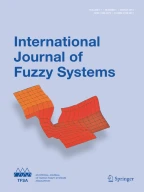Abstract
Fuzzy regression model is developed to construct the relationship between independent variable and dependent variable in a fuzzy environment. In order to increase the explanatory performance of fuzzy regression model, the least-squares method usually is applied to determine the numeric coefficients based on the concept of distance. In this paper, we consider the fuzzy linear regression model with fuzzy input, fuzzy output, and crisp parameters, introduce a new distance based on the incentre point of triangular fuzzy number, merge least-squares method with the new incentre distance, and propose least-squares incentre distance (LSID) method. Finally, an example of employee job performance is given to illustrate the effectiveness and feasibility of the method. Comparisons with existing methods show that the calculation of LSID method is simpler on the premise of total estimation error satisfaction.
Similar content being viewed by others
Explore related subjects
Discover the latest articles, news and stories from top researchers in related subjects.References
Tanaka, H., Uejima, S., Asai, K.: Linear regression analysis with fuzzy model. IEEE Trans. Syst. Man Cybern. 12(6), 903–907 (1982)
Celminš, A.: Least squares model fitting to fuzzy vector data. Fuzzy Set Syst. 22(3), 245–269 (1987)
Diamond, P.: Fuzzy least squares. Inform. Sci. 46(3), 141–157 (1988)
Chang, Y.H., Ayyub, B.M.: Fuzzy regression methods—a comparative assessment. Fuzzy Set Syst. 119(2), 187–203 (2001)
Tanaka, H., Ishibuchi, H.: Identification of possibilistic linear systems by quadratic membership functions of fuzzy parameters. Fuzzy Set Syst. 41(2), 145–160 (1991)
Chang, P.T., Lee, E.S.: Fuzzy linear regression with spreads unrestricted in sign. Comput. Math. Appl. 28(4), 61–70 (1994)
Hojati, M., Bector, C.R., Smimou, K.: A simple method for computation of fuzzy linear regression. Eur. J. Oper. Res. 166(1), 172–184 (2005)
Chou, T.Y., Liang, G.S., Han, T.C.: Application of fuzzy regression on air cargo volume forecast. Qual. Quant. 45(6), 1539–1550 (2011)
Hsieh, W.Y., Tsaur, R.C.: Epidemic forecasting with a new fuzzy regression equation. Qual. Quant. 47(6), 3411–3422 (2013)
Liu, Y.Y., Chen, Y.Z., Zhou, J.: Fuzzy linear regression models for QFD using optimized h values. Eng. Appl. Artif. Intel. 39(3), 45–54 (2015)
Chen, F.N., Chen, Y.Z., Zhou, J., Liu, Y.Y.: Optimizing h value for fuzzy linear regression with asymmetric triangular fuzzy coefficients. Eng. Appl. Artif. Intel. 47(1), 16–24 (2016)
Yang, M.S., Lin, T.S.: Fuzzy least-squares linear regression analysis for fuzzy input–output data. Fuzzy Set Syst. 126(3), 389–399 (2002)
Coppi, R., D’Urso, P., Giordani, P., Santoro, A.: Least squares estimation of a linear regression model with LR fuzzy response. Comput. Stat. Data Anal. 51(1), 267–286 (2006)
Chen, L.H., Hsueh, C.C.: Fuzzy regression models using the least-squares method based on the concept of distance. IEEE Trans. Fuzzy Syst. 17(6), 1259–1272 (2009)
Wu, H.C.: The construction of fuzzy least squares estimators in fuzzy linear regression models. Expert Syst. Appl. 38(11), 13632–13640 (2011)
Roldán, C., Roldán, A., Martínez-Moreno, J.: A fuzzy regression model based on distances and random variables with crisp input and fuzzy output data: a case study in biomass production. Soft Comput. 16(5), 785–795 (2012)
Lee, W.J., Jung, H.Y., Yoon, J.H., Choi, S.H.: The statistical inferences of fuzzy regression based on bootstrap techniques. Soft. Comput. 19(4), 883–890 (2015)
Zeng, W.Y., Feng, Q.L., Li, J.H.: Fuzzy least absolute linear regression. Appl. Soft Comput. 52(3), 1009–1019 (2017)
Hesamian, G., Akbari, M.G., Asadollahi, M.: Fuzzy semi-parametric partially linear model with fuzzy inputs and fuzzy outputs. Expert Syst. Appl. 71(4), 230–239 (2017)
Rouhparvar, H., Panahi, A.: A new definition for defuzzification of generalized fuzzy numbers and its application. Appl. Soft Comput. 30(3), 577–584 (2015)
Zadeh, L.A.: Fuzzy sets. Inf. Control 8(3), 338–353 (1965)
Zhang, Q., Xing, H., Liu, F., Ye, J.: Some new entropy measures for interval-valued intuitionistic fuzzy sets based on distances and their relationships with similarity and inclusion measures. Inform. Sci. 283(11), 55–69 (2014)
Kacprzyk, J.: Multistage fuzzy Control: A Prescriptive Approach. Wiley, Hoboken (1997)
Carlsson, C., Fullér, R.: On possibilistic mean value and variance of fuzzy numbers. Fuzzy Set Syst. 122(2), 315–326 (2001)
Kim, B., Bishu, R.R.: Evaluation of fuzzy linear regression models by comparing membership functions. Fuzzy Set Syst. 100(1), 343–352 (1998)
Jung, H.Y., Yoon, J.H., Choi, S.H.: Fuzzy linear regression using rank transform method. Fuzzy Set Syst. 274(9), 97–108 (2015)
D’Urso, P.: Linear regression analysis for fuzzy/crisp input and fuzzy/crisp output data. Comput. Stat. Data Anal. 42(1), 47–72 (2003)
Kao, C., Chyu, C.L.: A fuzzy linear regression model with better explanatory power. Fuzzy Set Syst. 126(3), 401–409 (2002)
Acknowledgements
The authors are very grateful to the editor and the anonymous reviewers for their constructive comments and suggestions that have led to an improved version of this paper. This paper is supported by the Humanities and Social Science Planning Fund of Ministry of Education of China (No. 18YJCZH036) and the Fundamental Research Fund for the Central University of China (No. 2015B28014).
Author information
Authors and Affiliations
Corresponding author
Rights and permissions
About this article
Cite this article
Gong, Y., Yang, S., Ma, H. et al. Fuzzy Regression Model Based on Incentre Distance and Application to Employee Performance Evaluation. Int. J. Fuzzy Syst. 20, 2632–2639 (2018). https://doi.org/10.1007/s40815-018-0536-x
Received:
Revised:
Accepted:
Published:
Issue Date:
DOI: https://doi.org/10.1007/s40815-018-0536-x
